

Uranium emits radiation inside a cloud chamber. Ever wondered what radiation looks like?

If you have, I bet you didn’t think it would look as cool as this. This is a small piece of uranium mineral sitting in a cloud chamber, which means you can see the process of decay and radiation emission. So, what’s a cloud chamber? It’s a sealed glass container cooled to -40°C, topped with a layer of liquid alcohol. Big Bang Theory. The Origin of the Universe - Stephen Hawking. The Origin of the Universe This lecture is the intellectual property of Professor S.W.Hawking.
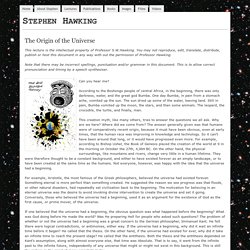
You may not reproduce, edit, translate, distribute, publish or host this document in any way with out the permission of Professor Hawking.Note that there may be incorrect spellings, punctuation and/or grammar in this document. This is to allow correct pronunciation and timing by a speech synthesiser. Can you hear me? According to the Boshongo people of central Africa, in the beginning, there was only darkness, water, and the great god Bumba.
Newton's 3 Laws of Motion. Newton's Laws of Motion Interactive. The Origin of Quantum Mechanics (feat. Neil Turok) Real-time fluid physics demo. What is a Wave? So waves are everywhere.
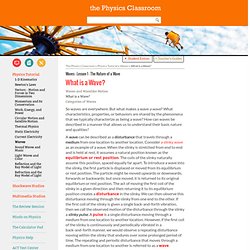
But what makes a wave a wave? What characteristics, properties, or behaviors are shared by the phenomena that we typically characterize as being a wave? How can waves be described in a manner that allows us to understand their basic nature and qualities? Visual way of illustrating the effects of gravitational acceleration. Earl Haig Secondary School - Physics Review Lessons. Black Holes: Gravity's Relentless Pull interactive. Radioactive Decay: A Sweet Simulation of Half-Life. PiccoloNamek [GFDL or CC-BY-SA-3.0], via Wikimedia Commons Introduction In this simulation, you will use small pieces of candy marked on one side.
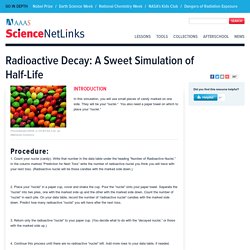
They will be your “nuclei.” You also need a paper towel on which to place your “nuclei.” 1. 2. 3. 4. Analysis:1. Frosty the Snowman Meets His Demise: An Analogy to Carbon Dating. Purpose To develop the idea that carbon dating is based on gathering evidence in the present and extrapolating it to the past.
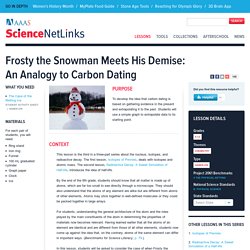
Students will use a simple graph to extrapolate data to its starting point. Context This lesson is the third in a three-part series about the nucleus, isotopes, and radioactive decay. Lesson: The Energy of Decay. (Provided courtesy of Think Green) Level: K-5 Time Frame: 1 initial session with additional observation days ABOUT THIS LESSON: (PDF version) In this lesson, students learn how decaying organic matter can be harvested as a source of energy.

After brainstorming ways that old metal, plastic, and paper can be a resource, students are challenged to find use for an old piece of fruit. This lesson may be used to address: NSES 4BPS1.1: Observable properties NSES 4BPS1.2: Materials and their properties NSES 4FSPSP3.3: The supply of many resources is limited Objectives: Students will describe physical properties of objects; they will also explain how waste can be turned into energy. Essential Question: How can waste be turned into energy? Instructional Activities (may include formative assessment within the lesson): 1. 2. FOOD DECAY leads to: GAS leads to: ENERGY Discuss how this process is an example of the fourth R in Reduce, Reuse, Recycle, and Recover. Radioactive Decay: A Sweet Simulation of a Half-life. PiccoloNamek [GFDL or CC-BY-SA-3.0], via Wikimedia Commons Purpose To demonstrate that the rates of decay of unstable nuclei can be measured, that the exact time that a certain nucleus will decay cannot be predicted, and that it takes a very large number of nuclei to find the rate of decay.
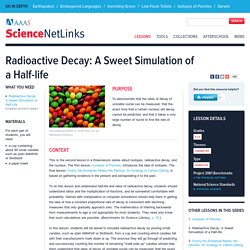
Context.
Your Age on Other Worlds. Want to melt those years away?
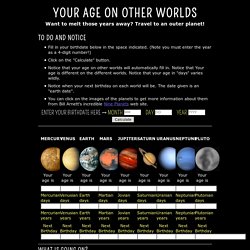
Travel to an outer planet! <div class="js-required"><hr> This Page requires a Javascript capable browser <hr></div> Fill in your birthdate below in the space indicated. (Note you must enter the year as a 4-digit number!) Click on the "Calculate" button. The Days (And Years) Of Our Lives Looking at the numbers above, you'll immediately notice that you are different ages on the different planets. The earth is in motion. Solar System, Solar System Information. Our Cosmic Neighborhood From our small world we have gazed upon the cosmic ocean for thousands of years.

Ancient astronomers observed points of light that appeared to move among the stars. They called these objects "planets," meaning wanderers, and named them after Roman deities—Jupiter, king of the gods; Mars, the god of war; Mercury, messenger of the gods; Venus, the goddes of love and beauty, and Saturn, father of Jupiter and god of agriculture. The stargazers also observed comets with sparkling tails, and meteors or shooting stars apparently falling from the sky. Since the invention of the telescope, three more planets have been discovered in our solar system: Uranus (1781), Neptune (1846), and, now downgraded to a dwarf planet, Pluto (1930). The four planets closest to the sun—Mercury, Venus, Earth, and Mars—are called the terrestrial planets because they have solid rocky surfaces. Nearly every planet—and some of the moons—has an atmosphere. See physics in action, get physics homework help.